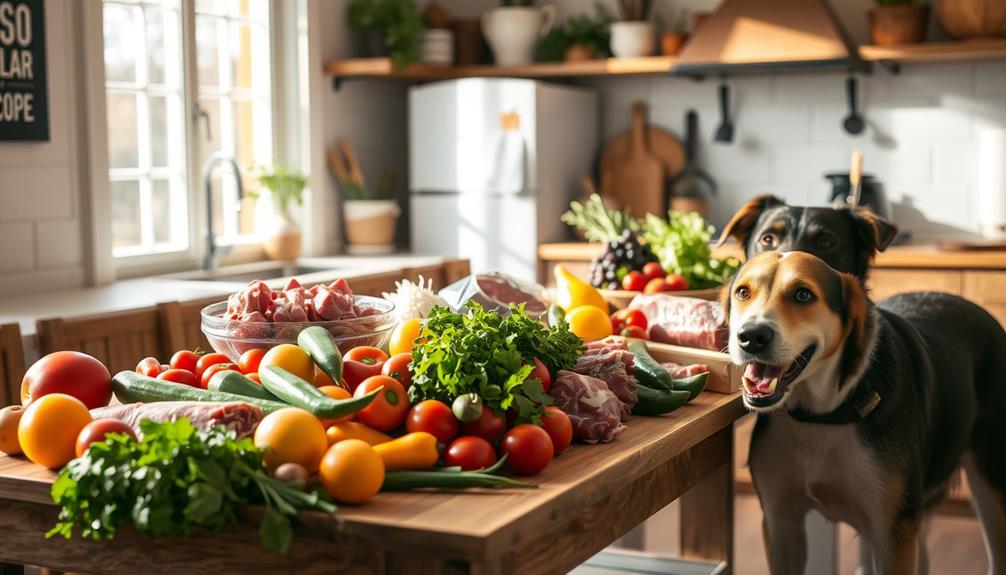To guarantee your puppy grows strong and healthy, you'll want to feed them between 5-10% of their body weight in raw food daily. For younger puppies, like those aged 8 weeks to 4 months, aim for 10%. As they reach 6 months, decrease the amount to about 5%. Focus on a balanced diet, incorporating muscle meat, raw bones, veggies, and liver. Regularly monitor their growth and adjust portions as needed to prevent obesity. If you're looking for more guidance on managing their diet and other essentials, there's certainly plenty more to explore.
Key Takeaways
- Puppies require 5-10% of their body weight in raw food daily, decreasing to 5% by six months of age.
- Younger puppies (8 weeks to 4 months) need 10% of their body weight for optimal growth.
- Transition to solid food should begin around 6 weeks, followed by a gradual shift to raw diet over 7-10 days.
- Regular weight checks are crucial for monitoring growth, adjusting portions, and preventing obesity.
- Consult a veterinarian for balanced nutrition and to address any dietary concerns during the transition to raw food.
Understanding Puppy Nutritional Needs
Understanding your puppy's nutritional needs is crucial for their healthy growth and development. When you're feeding a puppy, it's imperative to provide a balanced diet that includes essential nutrients.
Puppies require about 5-10% of their body weight in raw food daily, which will decrease to around 5% by six months of age. Proper diet choices, such as high-quality protein from muscle meat and balanced supplementation with vitamins from fruits and vegetables, can greatly influence your puppy's overall health and longevity.
Additionally, ultimate hamster care guide emphasizes the importance of regular monitoring of health and nutrition for small animals, which can also apply to your puppy's dietary routine.
A recommended BARF diet for puppies consists of 58% muscle meat, 17% raw edible bone, 7% vegetables, 7% liver, 7% other secreting organs, 3% seeds/nuts, and 1% fruit. This balanced diet guarantees your puppy gets the right mix of nutrients to thrive.
While using a raw puppy food calculator can help you determine the right amount of food based on your puppy's body weight, don't forget to regularly monitor their growth and activity levels. Adjust their food intake accordingly to maintain a healthy weight.
Daily Feeding Amounts

Determining how much raw food to feed your puppy can be straightforward if you consider their age, weight, and activity level. Puppies generally require about 5-10% of their current body weight in raw food daily, decreasing to around 5% by six months. For an 8-week-old puppy, feeding 10% of their body weight is common, whereas a 6-month-old may only need 4%. To ensure you are providing the right amount of raw food for your puppy, you can use a raw food calculator for puppies. This tool takes into account your puppy’s individual factors, such as age, weight, and activity level, to give you a more accurate estimate of how much food they need. By utilizing a raw food calculator for puppies, you can be confident that you are meeting your puppy’s nutritional needs as they grow and develop. When feeding raw food to dogs, it’s important to remember that every puppy is unique and may have different dietary needs. Factors such as breed, metabolism, and overall health can also play a role in determining the right amount of raw food to feed your puppy. Additionally, consulting with a veterinarian who is knowledgeable about feeding raw food to dogs can provide valuable guidance and ensure that your puppy receives a balanced diet.
To help you visualize, here's a quick guide:
| Age | Raw Food Percentage | Example for 10 lbs | Example for 20 lbs |
|---|---|---|---|
| 8 weeks | 10% | 1 lb | 2 lbs |
| 3 months | 8% | 0.8 lb | 1.6 lbs |
| 6 months | 5% | 0.5 lb | 1 lb |
| 1 year | 4% | 0.4 lb | 0.8 lb |
It's crucial to adjust feeding amounts based on your puppy's growth and activity level. Regular weight checks will help you monitor growth and guarantee proper nutrition. Using a puppy food calculator can provide a more tailored feeding plan based on weight and age.
Age-Specific Guidelines

When it comes to feeding your puppy, age plays a crucial role in determining the right amount of raw food.
Younger puppies need more food relative to their body weight, as their growth demands increased nutrition, while older puppies gradually require less as they grow.
It's important to be aware of financial considerations for elderly care, as this can help you plan for future expenses related to your pet's care.
Shifting to solid food also depends on their age, so it's imperative to follow age-specific guidelines for peak development.
Feeding Amount by Age
Feeding your puppy the right amount of raw food is essential for their growth and development at different stages. For puppies aged 8 weeks to 4 months, aim to provide about 10% of their current body weight in food daily. This supports their rapid growth during this critical period, similar to how proper nutrition influences key domains of development in early life.
As your puppy reaches 4 to 6 months, you should reduce their food intake to about 6-8% of their body weight, as their growth rate stabilizes.
When your puppy is between 6 to 8 months old, adjust their feeding amount further to around 4-6% of their body weight. This decrease reflects their diminishing growth needs.
Finally, from 8 to 12 months, the recommended intake drops to 2-4% of their ideal adult weight.
It's important to regularly monitor your puppy's weight during these milestones to guarantee they're getting the right amount of food. This monitoring will help you adjust their food intake as necessary, promoting healthy growth and preventing over or underfeeding.
Transitioning to Solid Food
As your puppy reaches around 6 weeks of age, it's time to start introducing solid food to their diet.
Begin with a bland and finely ground formula to supplement their mother's milk. This gradual shift helps them adjust without overwhelming their digestive system. You can use a weaning paste between 3 to 6 weeks to ease this process.
It's also important to take into account their overall health and consult with your veterinarian if you have any concerns regarding their diet or development, especially since cold medications overview can affect their growth if they experience illness.
By 8 weeks old, your puppy will need about 10% of their body weight in food, so keep a close eye on their growth.
As they grow, this amount will decrease to around 5% by the time they hit 6 months. At around 4 months, you should shift to normal puppy food formulas that provide a balanced mix of proteins, fats, and carbohydrates.
It's essential to maintain a feeding schedule of 3-4 meals per day during this transitional phase. This routine not only supports their growth but also helps establish good eating habits.
Calculating Food Portions

Calculating the right food portions for your puppy is essential to ensuring they grow healthy and strong. Puppies typically require 5-10% of their current body weight in raw food daily, which is critical for their overall health and development.
Understanding the concept of a budget for pet care can also help you plan for ongoing food and health expenses. Younger puppies, like an 8-week-old weighing 5kg, need around 250g to 500g of raw food each day. As they grow, their food requirement usually decreases; by the time they reach about 6 months, it drops to approximately 5% of their body weight.
To calculate food portions accurately, use a puppy food calculator that considers your puppy's weight and age. This tool helps you determine the precise daily feed volume for ideal nutrition.
It's essential to monitor a puppy's weight regularly, adjusting food portions as needed to support healthy growth and prevent obesity.
Monitoring Growth and Weight
Monitoring your puppy's growth and weight is essential for guaranteeing they develop healthily. Regularly check their weight weekly to confirm they're growing appropriately. If you notice any changes, adjust the feeding amounts of their food accordingly.
For puppies aged 2-4 months, aim to feed them about 8%-10% of their current weight in food daily to support their rapid growth. As they approach 6-8 months, you'll need to decrease their food intake to about 4%-6% of their weight, reflecting their slowing growth rate. Providing a variety of flavors in their diet can keep them engaged and satisfied, which is important during their growth phase healthy dog snacks.
Keep an eye on their body condition too. A visible waist and slight rib visibility are indicators of a healthy weight. If you notice excessive fat coverage, it may be time to adjust the amounts of food you're feeding.
Additionally, monitor your puppy's stool consistency. Firm stools typically suggest a balanced diet, while loose stools might indicate overfeeding or an imbalance in their diet. If you encounter this, reassess their food portions to guarantee they're getting the right nutrition without excess.
Transitioning to Raw Diet

Shifting your puppy to a raw diet should be a gradual process to keep their tummy happy.
Start by introducing one protein source at a time and closely watch for any signs of digestive upset.
It's important to guarantee that the raw food is of high quality, as the nutritional benefits can greatly impact your puppy's health.
Creating a calm feeding environment can also help your puppy adjust to the new food, which is similar to how juice diets may lead to nutrient deficiencies if not balanced properly.
Gradual Diet Transition
When you're ready to switch your puppy to a raw diet, it's important to ease them into it gradually. This change helps minimize digestive upset and guarantees your puppy adjusts well to the new food. Over a period of 7-10 days, follow these steps for a smooth change:
- Start Small: Begin by introducing small portions of raw food, gradually increasing the amount each day. Incorporating essential oils for respiratory health can also support your puppy's overall wellness during this change.
- Mix Wisely: If your puppy has been on kibble for a while, mix the raw food with their current diet initially, but avoid this for first-time raw feeders.
- Introduce One Source: Focus on one protein source at a time. This way, you'll easily spot any digestive issues or allergies that may arise.
- Regular Feeding Schedule: Feed your puppy three times daily until they reach six months. After that, you can reduce meal frequency.
Consult with a veterinarian for personalized guidance throughout this change. They can help you tailor the raw diet to your puppy's specific needs, guaranteeing a balanced and healthy approach.
Monitoring Puppy Health
As you commence this journey with your puppy's raw diet, keeping a close eye on their health is fundamental for a successful shift. Monitor your puppy's weight weekly to guarantee they're growing at a healthy rate. Adjust food amounts based on their age and activity level.
Pay attention to stool consistency; smaller, firmer stools typically indicate proper digestion and nutrient absorption. If you notice loose stools, it might be time to adjust their diet. Additionally, making sure your home remains clean can help prevent any distractions during feeding, similar to how vacuums for pet hair can effectively manage pet-related messes.
Regularly assess your puppy's overall health and energy levels. Improvements in coat condition and liveliness can signal a successful shift to a raw diet. Keep track of their feeding habits, noting any changes in appetite or reluctance to eat, as these could indicate digestive issues or the need to switch protein sources.
Throughout this shift, consulting a veterinarian is essential. They'll help guarantee your puppy's nutritional needs are being met and address any concerns that arise.
Feeding Environment Tips
Creating a calm and inviting feeding environment is essential for helping your puppy adjust to their new raw diet. A relaxed atmosphere can greatly reduce anxiety during mealtime, making the shift smoother.
Incorporating elements that promote well-being can enhance your puppy's eating experience, much like how understanding brewing methods can elevate your coffee enjoyment various brewing methods.
Here are some tips to enhance the feeding environment:
- Choose a Quiet Space: Find a quiet spot in your home where your puppy can eat without distractions, allowing them to focus on their food.
- Use Clean Utensils: Always make sure that feeding bowls and utensils are clean to prevent contamination, promoting your puppy's health and hygiene.
- Monitor Portions: Start with small portions of raw food to help your puppy's digestive system adapt. Gradually increase the amount as they become more comfortable with the new diet.
- Observe Eating Habits: Pay attention to your puppy's preferences and eating habits. Tailoring their raw diet to their tastes can encourage better acceptance and enjoyment of mealtime.
Benefits of Raw Feeding

Feeding your puppy a raw diet comes with a multitude of benefits that can greatly enhance their growth and overall health. One of the key benefits of raw feeding is that it provides essential nutrients that support ideal growth during their formative months. As a result, you'll likely notice your puppy experiencing improved digestion and nutrient absorption, which can lead to a healthier coat and increased energy levels.
A raw diet also plays a significant role in strengthening your puppy's immune system. By supplying whole food ingredients, you're giving them natural nutrition that reduces the risk of allergies and other health issues. This holistic approach contributes to better overall health.
Additionally, raw feeding promotes excellent dental health. The natural chewing involved with raw food helps prevent plaque buildup, leading to stronger teeth and gums.
You'll appreciate how raw diets eliminate synthetic fillers, ensuring your puppy receives high-quality nutrition that supports long-term health and longevity.
Common Challenges

While raw feeding offers numerous advantages for your puppy, it also presents some common challenges that you'll need to navigate.
To guarantee your puppy thrives on a raw diet, consider the following:
- Gradual Shift: Shifting your puppy to a raw diet should happen over 7-10 days. Start with small portions and monitor their tolerance to avoid digestive upset.
- Picky Eaters: If your puppy previously ate highly palatable kibble, they may need time to adjust. Introducing fresh foods early on can help prevent picky eating habits.
- Nutritional Balance: It's crucial to guarantee proper nutritional balance. Consulting with a veterinarian can help you determine how much of each ingredient to feed a puppy, ensuring they receive all essential nutrients.
- Regular Monitoring: Keep an eye on your puppy's weight and body condition. Visible waist and rib visibility are signs of healthy growth, and you may need to adjust their diet based on their activity levels.
Community Support and Resources

Steering through the world of raw feeding can feel overwhelming, but connecting with the right community can make all the difference. Joining an online group like The Pack gives you access to expert advice and shared experiences that can enhance your puppy care journey.
Regular discussions on puppy nutrition within these platforms help address common concerns, providing valuable insights for new puppy owners.
You'll also discover various subscription services that offer discounts and bulk purchasing options for raw puppy food, making it easier to manage costs while ensuring your pup gets quality nutrition.
If you prefer shopping in-store, local stockist finders are available, guiding you to nearby raw food options.
For those just starting out, many brands offer starter packs tailored for new pet owners. These packs allow you to experiment with raw feeding using manageable portions and guided information, easing you into this new feeding regimen.
Frequently Asked Questions
How Much Raw Food to Feed a Puppy Chart?
When considering how much raw food to feed your puppy, refer to a feeding chart that factors in age and weight. This'll help you determine the right daily percentage for healthy growth and development.
What Are the Guidelines for Raw Feeding Puppies?
Imagine nurturing a young tree, feeding it just the right amount of sunlight and water. For your puppy, provide balanced meals, monitor growth weekly, and adjust portions to guarantee a healthy, thriving companion.
What Is the 80 10 10 Rule for Raw Dog Food?
The 80/10/10 rule for raw dog food means you should feed your puppy 80% muscle meat, 10% raw bone, and 10% organ meat. This balance guarantees they get the nutrients needed for healthy growth.
How Many Pounds of Raw Food Should I Feed My Puppy?
To determine how many pounds of raw food to feed your puppy, consider their weight and age. Generally, you'll feed about 5-10% of their body weight daily, adjusting based on growth and activity.
Conclusion
Feeding your puppy the right amount of raw food can feel overwhelming, but remember, it's about balancing nourishment and love. As you watch your pup thrive on a diet that mirrors their natural instincts, you'll find joy in their energy and liveliness. Yet, the challenges can sometimes weigh heavy on your heart. Embrace the journey, lean on your community, and celebrate each milestone—because every meal is a step toward a healthier, happier life for your furry companion.










